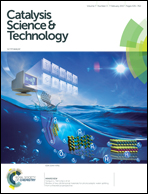Effect of in situ Fe(ii)/Fe(iii)-doping on the visible light-Fenton-like catalytic activity of Bi/BiOBr hierarchical microspheres†
Abstract
Novel Fe(II)/Fe(III) doped Bi/BiOBr (FBB) visible light photocatalysts with heterojunctions were successfully prepared by a facile solvothermal method. The as-prepared samples were characterized via XRD, FESEM, XPS, UV-vis absorption spectroscopy and N2 adsorption–desorption. The results demonstrate that Fe doping plays key roles in the transformation of amorphous to crystal phase for Bi metal nanoparticles and the increase of specific surface areas for FBB. The degradation of rhodamine B (RhB) was studied using FBB with hydrogen peroxide (H2O2) under visible light irradiation (λ = 420 nm); it was found that the degradation rate constant for 0.2-FBB (Fe/Bi molar ratio = 0.2) is 4-fold more than that for pure BiOBr. The presence of visible light enhances the Fenton-like reaction by the reduction of ![[triple bond, length as m-dash]](https://www.rsc.org/images/entities/char_e002.gif) Fe(III) to
Fe(III) to ![[triple bond, length as m-dash]](https://www.rsc.org/images/entities/char_e002.gif) Fe(II), producing more holes and hydroxyl radicals to degrade RhB. This result is confirmed by ESR spectroscopy, H2O2 consumption and surface Fe(II) concentration experiments. Radical scavenger experiments demonstrated that the active species follow the order holes > hydroxyl radicals. After five cycles, 0.2-FBB retains stable catalytic activity.
Fe(II), producing more holes and hydroxyl radicals to degrade RhB. This result is confirmed by ESR spectroscopy, H2O2 consumption and surface Fe(II) concentration experiments. Radical scavenger experiments demonstrated that the active species follow the order holes > hydroxyl radicals. After five cycles, 0.2-FBB retains stable catalytic activity.



 Please wait while we load your content...
Please wait while we load your content...